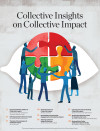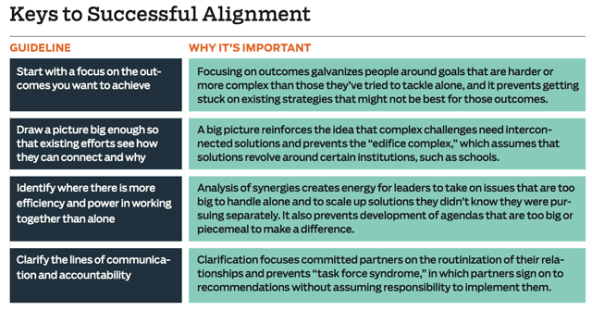SPONSORED SUPPLEMENT TO SSIR PRODUCED FOR THE COLLECTIVE IMPACT FORUM
Collective Insights on Collective Impact

This special supplement features the most recent thinking and learning about how to use the collective impact approach to address large-scale social and environmental problems.
-
Essential Mindset Shifts for Collective Impact
-
Defining Quality Collective Impact
-
The Role of Grantmakers in Collective Impact
-
Power Dynamics in Collective Impact
-
Roundtable on Community Engagement and Collective Impact
-
Aligning Collective Impact Initiatives
-
Learning in Action: Evaluating Collective Impact
-
Achieving Collective Impact for Opportunity Youth
-
Making Public Policy Collective Impact Friendly
Northern Kentucky was a hotbed of collective impact initiatives long before anyone called them “collective impact.” For decades, the region’s government and civic leaders have tackled thorny social issues through partnerships to create a vision for the region’s future and to implement plans to fulfill that vision. “We were doing collective impact,” says the vice president of one such effort. “We just didn’t have those words.”
When it came to education initiatives, however, Northern Kentucky had too much of a good thing. Initiatives were created to foster collaboration among educators, among educators and businesses, and among educators, businesses, government, and civic organizations. Countless other organizations had a hand in education as part of their missions to help children and families. “You would sit in these meetings and hear lots of good ideas,” recalls Patricia Nagelkirk, director of community impact for education at the United Way of Greater Cincinnati. “But there was no coordinator or game plan to carry them out.”

As collective impact initiatives blossom around the country, Northern Kentucky provides a case study in handling a dilemma that can spring from that growth: When multiple initiatives develop overlapping missions, members, and audiences, how can you reduce competition and increase impact?
Today, Northern Kentucky’s education initiatives are aligned through a backbone organization that aims to improve all youth supports, from birth to career. To achieve that goal, local leaders grappled with issues like: Which existing groups can deliver backbone supports? How is backbone support funded? What do the initiatives do about areas where their work overlaps? Do any existing initiatives need to fold? Finding the answers took two years and a lot of analysis, negotiation, and, as Northern Kentucky leaders note, some frank and “uncomfortable” conversations. (See “Keys to Successful Alignment” above.)
Motivation to Align
The dilemma was born of abundance. Through the 1990s and early 2000s, several partnerships and initiatives were launched to improve educational services in Northern Kentucky (an area defined as anywhere from four to nine counties south of the Ohio border). The Council of Partners in Education sought to improve collaboration among secondary and post-secondary institutions. The Northern Kentucky Education Alliance, a venture of the Chamber of Commerce, worked to increase cooperation between schools and businesses. Vision 2015, which fostered cross-sector collaboration to improve economic and social conditions, had an Education Implementation Team. Some people were involved in all of these efforts and ran into each other at every meeting. “In any given week,” recalls educator Polly Lusk Page, “you could go to three meetings and hear the same report three times.”
The initiatives competed for resources and attention from the same audiences. Although they worked together to varying degrees, they had no overarching strategy, and efforts to collaborate were complicated by a challenge that’s typical in rural and suburban areas: the presence of dozens of jurisdictions covering a large region.
Lusk Page recalls the frustration expressed by Vision 2015’s leaders: “We have too much going on. We have a lot of duplication of effort, and the business community is saying, ‘Too many people are coming to us with too many asks.’ ” Vision 2015 posited an idea: “What would it look like if we realigned?”
Finding the answer took two years of research and discussions. Because several organizations felt qualified to lead the new structure, these processes were facilitated primarily by neutral organizations.
Two processes somewhat overlapped. In 2008, Vision 2015 launched a series of discussions with education stakeholders about aligning their efforts under one umbrella. (Vision 2015 harbored no desire to be the umbrella; its agenda extended beyond education.) Then in 2009, the United Way of Greater Cincinnati (which covers Northern Kentucky) signed on with our national nonprofit organization, the Forum for Youth Investment, to facilitate the implementation of Ready by 21—a set of collective impact strategies to help communities get young people “ready for college, work, and life” by strengthening partnerships, developing shared goals, and measuring progress.
Kara Williams, Vision 2015’s vice president of communication and strategic initiatives, says that among the keys for success were “having the right people in the room” who could make decisions for their organizations, and having motivated leaders. “They felt the confusion, the pain” of unaligned work. “They felt that together they could be doing more than they were doing separately.”
Give and Take
The Council of Partners in Education emerged as a candidate for the backbone role because of its strong connections to school districts and education leaders. The Council set out to become “the overarching organization for the alignment of education initiatives” in the region; it renamed itself the Northern Kentucky Education Council (NKYEC).
But although everyone was grateful to Vision 2015 for launching the alignment project, enthusiasm for alignment was tempered by uncertainty over whether the NKYEC would intrude on ground staked out by others. “We were dealing with multiple organizations, and understandably, some leaders had turf issues,” said Lusk Page, now executive director of the NKYEC. “Everyone was invested” in their community change work and “some didn’t want to give up what they were doing.”
They didn’t have to. The NKYEC preferred to coordinate with existing initiatives rather than start new ones; it found ways for other organizations to align their work with its priorities. That alignment was eased by the NKYEC’s creation of six “action teams,” each focused on an objective (such as “college and career readiness” and “educator excellence”) and composed of representatives from organizations that belong to the NKYEC. The teams allow the organizations to both sync with and influence the NKYEC, because the teams help to steer and implement its mission.
Some initiatives did disappear, but their work did not. Members of the Education Alliance (the Chamber of Commerce initiative) ran the action team on Business Involvement and Service Learning. That rendered the Alliance moot; it dissolved. So too did Vision 2015’s Education Implementation Team, because the NKYEC crafted new bylaws to promote Vision 2015’s educational goals. “We funneled all of those resources [for the education team] into the Council,” Williams said. Integrating people and resources among organizations facilitated the alignment’s success.
Getting Ambitious
Even while this process settled questions, the renovations continued. The Ready by 21 staff, working through the United Way, led an examination of the region’s goals for young people, the available resources, and the steps needed to achieve the goals. That examination pushed stakeholders to expand their vision in two ways: to focus on specific youth outcomes and to extend beyond education.
One of Ready by 21’s fundamental concepts is the “Insulated Education Pipeline,” which says communities must ensure a full array of cradle-to-career supports beyond academics, in such areas as early childhood, health, safety, social connections, and job skills. “That pipeline,” says Lusk Page, “helped people understand in a way that we never understood before that we can work on the academic pipeline all we want, but until we broaden our scope and think about these wrap-around supports that our families and youth need, this isn’t going to work.”
Building an insulated pipeline of supports meant creating and strengthening partnerships between education organizations and others that provide everything from after-school activities to job training. The umbrella question arose again: Could one group coordinate these stakeholders? The NKYEC united local education efforts, but the United Way was the lead partner in Ready by 21, which brought funding and technical assistance. The NKYEC and United Way had not worked together much, and their geographic coverage in Northern Kentucky did not exactly match.
“There were some very candid conversations in our initial meetings” about what organization should lead the broader work, Lusk Page recalls. The United Way grew convinced that the NKYEC was up to the task, but each party needed assurances about responsibilities and resources. Those were laid out in a 2010 memorandum of understanding between the United Way, NKYEC, and Vision 2015. They agreed, for the purpose of the broader work, to adopt the NKYEC’s geographic footprint (6 counties, 37 municipalities, and 18 school districts), and that Vision 2015 would pay for a part-time staff member for the NKYEC to carry out the work.
Thus the NKYEC stretched further. Its desired outcomes now include not just academic achievement but the overall well-being of young people. It advocates birth-to-career supports, adding early childhood on the younger end, for example, and workforce development for older youths. And its bylaws mandate equal seats for education, business, and community leaders (such as nonprofit service providers) on its board of directors.
Results
Leaders of the NKYEC effort are cautious about drawing connections just yet between the collective impact strategies and population-level outcomes. Nonetheless, Lusk Page says, “the needle’s starting to move” on some indicators, such as reading levels, graduation rates, and measures of college and career readiness. More visible are the on-the-ground changes in the services and supports that young people receive, thanks largely to the work of the action teams.
- Education and business groups launched initiatives to prepare more high school students for college and careers, such as increasing enrollments in dual-credit courses, mapping local career readiness resources, and training teachers to integrate 21st-century skills development in their classrooms.
- More than 80 schools administered an enhanced version of the Gallup Student Poll, which measures hope, engagement, and well-being. Schools combine the findings with data about grades and attendance, using the results to steer students to school supports (such as life skills courses) and to increase after-school opportunities (such as leadership development programs).
- The NKYEC, the United Way, and the Strive Partnership launched a literacy campaign with more than 70 partners.
Realignment resolved the problem that leaders set out to solve: Northern Kentucky has moved from having “no coordinator or game plan” and disparate collective impact initiatives to embracing a highly coordinated system.
The leaders of these efforts feel that they are poised to accomplish changes that they could not have imagined before. The NKYEC, for example, is working with the Forum for Youth Investment and SAS (a business analytics software and services company) to pilot a diagnostic system to link efforts to impact. The system will gather and display data from multiple sources and show how resource allocation and community supports affect outcomes for children and youths. “For the first time, we will have the power to see our impact and make adjustments,” says Lusk Page. “We’ll really know if we are making a difference.”
Support SSIR’s coverage of cross-sector solutions to global challenges.
Help us further the reach of innovative ideas. Donate today.
Read more stories by Merita Irby & Patrick Boyle.

